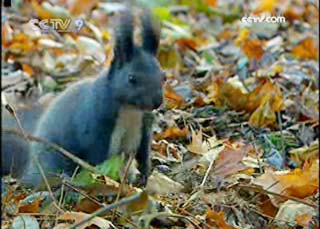------Program code: NS-080819-01670 (what's this?)
Source: CCTV.com
08-19-2008 09:36
The waterfall pours down a 68-metre cliff in the Changbai Mountains. Three rivers have their source here; the Songhua, the Tumen and the Yalv.
 |
The tundra belt, located at an altitude of 2,000 metres in the Changbai Mountains, is home to the plateau pikas .
In autumn, the plateau pikas eat huge amounts of food, in anticipation of the coming winter snow.
 |
The Changbai Mountains have 16 peaks, all of which rise above 2,500m. The main peak is the highest point in Northeast Asia. The peaks surround Lake Tianchi, or Heavenly Lake, the highest and deepest alpine lake in China. Lake Tianchi occupies the crater of a dormant volcano.
Water from the lake flows into the waterfall. At the bottom it crosses the only perfectly preserved mountain tundra belt in the Far East, and from there it flows on through forests of birches, spruces and firs. After that, at a slower pace, it meanders through vast mixed forests of broad-leaf and Korean pines.
One Korean pine standing beside the river is an impressive 38 metres tall. The locals call it the King of Korean Pines.
The tree is over 480 years old. Numerous of its offspring surround it.
Broad-leaf and Korean pine forests are common in Northeast China. They account for a large part of the forested area. Although pines dominate, there are many other tree species, nearly 50 in all, including Mongolian oaks and Manchurian ashes.
The broad-leaf trees have stopped their photosynthesis, in preparation for the coming winter.
At the base of the King of Korean Pines, three grey squirrels are busy searching among the leaves.
The broad leaf trees are yellowing, but the King of Korean Pines is still fresh and green. The Korean pine is a conifer, and it never sheds its leaves, however harsh the winter.
The grey squirrels are well equipped for dealing with the hard shells.
The shrew pokes its ugly face out of the hole in the tree trunk and eats the leaves that have not yet turned yellow.
Chipmunks are close relatives of the grey squirrels, although somewhat smaller. There is still plenty of food left, and they are trying to store away as much as possible, before the onset of winter.
For the next 40 days, the forest dwellers will be busy storing the food they need to survive through the winter months
The parus majors are enjoying the buds. But this particular delicacy will soon disappear with the coming of winter.
The black bears are the most formidable animals in the Korean pine forests. Many of the smaller creatures try to avoid encountering them. But the bears aren’t as fearsome as their reputation suggests. Occasionally they may feast on field mice or young wild boars. But most of the time they prefer a vegetarian diet.
Ripe berries are the black bears’ favorite. Throughout the autumn their main preoccupation is to eat as many nuts and fruits as possible. It is an astonishing weight-gain programme that can see them put on as much as a kilo a day.
What lies in store for them is five months of hibernation.
Korean pine cones, a main item in the black bears’ diet, are still hanging from the high branches.
Korean pine cones are extremely large by comparison with the rest of the coniferous gymnosperm. Each cone contains hundreds of nuts, and it’s these that will keep the bears alive.
Editor:Yang
